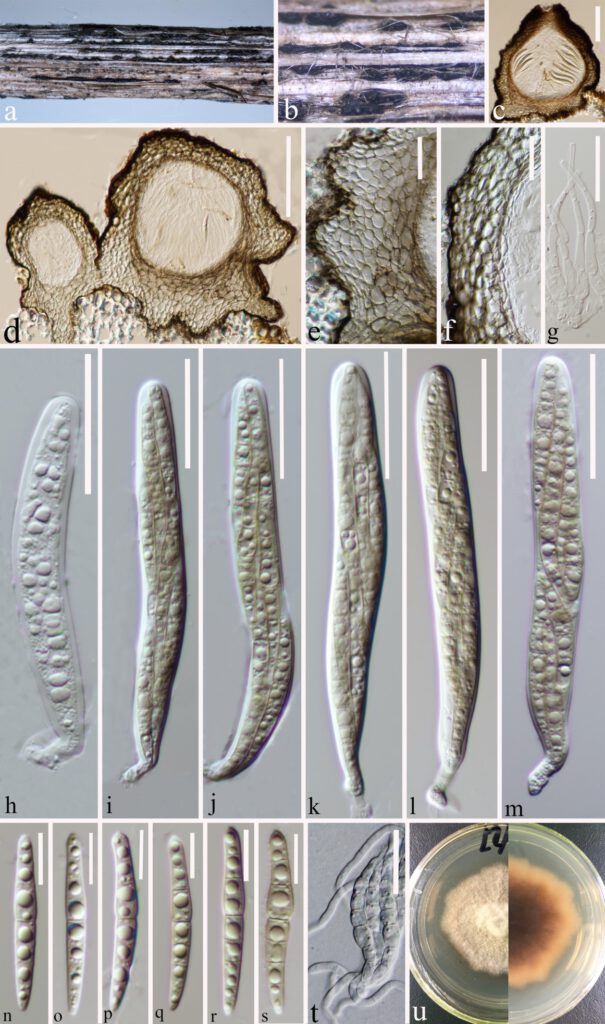Plenodomus zhaotongensis Y. Gao, H. Gui & K.D. Hyde, sp. nov.
MycoBank number: MB; Index Fungorum number: IF ; Facesoffungi number: FoF 12903; FIGURE 3. ZG17.
Etymology: The specific epithet “zhaotongensis” refers to Zhaotong city where the holotype was collected.
Holotype: HKAS 124668
Saprobic on decaying stalk of grass. Sexual morph: Ascomata 200–300 μm diam × 210–320 μm high (x̅ = 240 × 298 μm, n = 15), scattered, most are gregarious, raised, superficial with base seated in the substrate, globose to subglobose or irregular, apically conical, dark brown to black, uni-loculate, glabrous, coriaceous, ostiolate, papillate ostiole, wider and flattened at the base, connected by very thin stromatal tissue at the base. Peridium (22–)29–54(–79) μm thick, (x̅ = 42 μm, n = 50), composed of two type scleroplectenchymatous cells layers, thick-walled of unequal thickness, thickened at base, thinner toward sides and apex, outer layer of amorphous black cells, inner layers composed of hyaline to pale brown cells of textura angularis to textura globulosa. Hamathecium (1.4–)2–3.7(–6) μm wide, (x̅ = 3 μm, n = 45), septate, hyaline, unbranched, broad at base, tapering upwards, pseudoparaphyses. Asci (80–)97–120(–132) × (10–)11–13(–14) μm (x̅ = 109 × 12 μm, n = 20), 8-spored, arising from base, fissitunicate, bitunicate, cylindric-clavate, initially hyaline, short pedicellate with foot-like pedicel, with ocular chamber, thick-walled at the apex. Ascospores (34–)35–39(–42) × (3.5–)4–5(–6) μm (x̅ = 37 × 4.5 μm, n = 30), overlapping, 2–3-seriate, initially hyaline, becoming pale yellowish at maturity, guttulate, lunate to long fusiform, straight or slightly curved, with 6 transverse septa at maturity, often constricted at medium septum, widest at the middle, rounded or slightly pointed at both ends, without mucilaginous sheath. Asexual morph: Undetermined.
Culture characteristics: Ascospores germinated on PDA within 20 hours and germ tube initially produced from the 2 ends of the ascospores. Colonies on PDA reaching 20 mm in 4 weeks at room temperature (15–27°C), irregular, flat, center is slightly raised, panniform, mycelium grows on the surface of PDA, white from the above, brown in the center gradually pale yellow towards the edges from the below. Asexual spores and sexual spores were not formed on PDA within 60 days.
Material examined: CHINA, Yunnan Province, Zhaotong city, Daguan County Grassland (27°44’23”N, 103°47’59”E), on decaying stalk of herbaceous plant, 21 August 2021, Ying Gao, ZG17 (HKAS 124668, holotype), ex-type living culture, CGMCC 3.23746.
Note: Plenodomus zhaotongensis is introduced as a new species based on its distinct morphology and analysis of a combined SSU, LSU, ITS, tub2 and rpb2 dataset. Plenodomus zhaotongensis clusters close to Plenodomus agnitus strain (CBS 121.89) with 90% ML and 1.00 BYPP bootstrap support (Fig1). A nucleotide pairwise comparison showed that Plenodomus zhaotongensis differs from Plenodomus agnitus (CBS 121.89) in 12/529 bp of ITS (2.27 %), 12/341 bp of tub2 (3.52 %), 18/766 bp of rpb2 (2.35 %). Therefore, following the guidelines for species delineation described by Jeewon and Hyde (2016), we introduce Plenodomus zhaotongensis as a novel taxon

FIGURE 3. Plenodomus zhaotongensis (HKAS 124668 holotype) on decaying stalk of herbaceous plant. a, b. Ascomata on the host. c, d. Vertical section of the ascoma. e. Vertical section of the base of peridium. f. Peridium. g. Hermathecium. h–m. Asci. n–s. Ascospores. t. Germinating ascospores. u. Front and reverse of colony on PDA. Scale bars: c, d = 100 μm, e–m = 30 μm, n–s = 10 μm, t = 20 μm.
